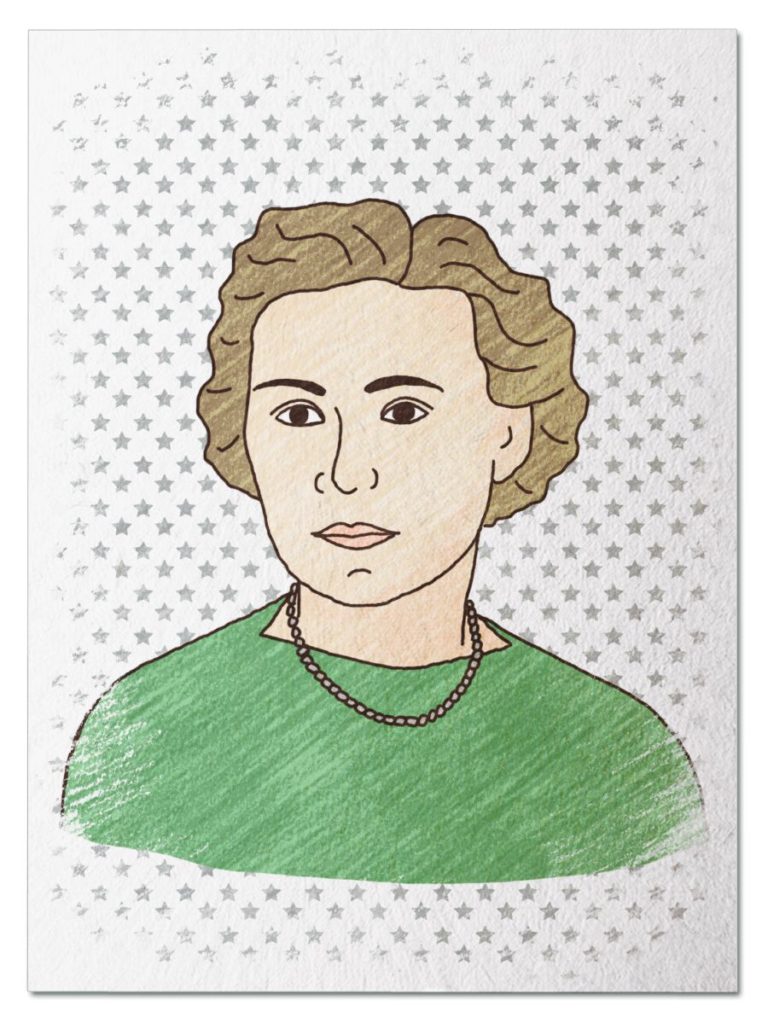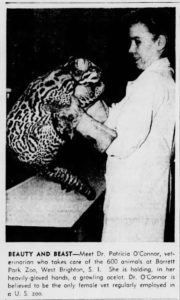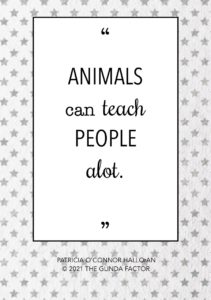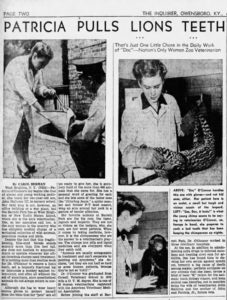
Health Hero
She dreamed of being a veterinarian as a little girl in the 1930s, pretending that her pet dogs and cats were her patients. When she grew up, she became one of a handful of women veterinarians but ended up in a career completely different from the one she had envisioned – instead of house pets, her patients were lions, tigers, monkeys, birds and snakes! Take a trip to the 1943 Staten Island Zoo and meet the first woman zoo veterinarian…Patricia O’Connor Halloran.
Her Ruby Shoe Moment
The Power of the Wand
Her Yellow Brick Road
Brains, Heart & Courage
Glinda’s Gallery
Just the Facts
Her Ruby Shoe Moment
 It had been a long hot summer day for Dr. Patricia O’Connor Halloran, the Staten Island Zoo’s staff veterinarian and chief animal caretaker. But as always, she reveled in the fact that she had built a career beyond her childhood dreams. She loved how every day brought something different: removing a lion’s infected tooth, setting a leopard’s broken leg or a bird’s broken wing, wrestling with the badgers (who did not like being handled!), laughing at the chimpanzees as they inspected her equipment and looked for the medicine they loved to eat, given scheduled immunizations and generally treating infections, illnesses, and arthritis as her animal patients required.
It had been a long hot summer day for Dr. Patricia O’Connor Halloran, the Staten Island Zoo’s staff veterinarian and chief animal caretaker. But as always, she reveled in the fact that she had built a career beyond her childhood dreams. She loved how every day brought something different: removing a lion’s infected tooth, setting a leopard’s broken leg or a bird’s broken wing, wrestling with the badgers (who did not like being handled!), laughing at the chimpanzees as they inspected her equipment and looked for the medicine they loved to eat, given scheduled immunizations and generally treating infections, illnesses, and arthritis as her animal patients required.
Pat had been hired on an interim basis about 18 months before, in early 1942. She expected to be replaced when the war ended and soldiers re-entered the workforce, but still was approaching the job as if she would be there for years. In the short time since she started, Pat had become the engine that kept the Zoo running. While her primary responsibility was medical care for the animals, she had taken on many other tasks. The Zoo opened with a large snake collection gifted by a donor, so Pat took charge of building up the mammal and bird communities. She also was working on educational programs for the public.
Pat had been interviewed for a newspaper article about her work at the Zoo and she grabbed a copy of the evening paper to see if tonight was the night it would be featured. It was. While the article elevated her status as the “only woman in the country who has complete medical charge of a zoological collection of wild animals, poisonous snakes, and birds,” to her colleagues at the Zoo, she was simply “Doc.”
At the time she was hired, Pat was one of only 25 women veterinarians in the country. And there were hardly any veterinarians, men or women, who devoted their practice to zoo veterinary medicine. It was a brand new profession. There were no training programs, textbooks, or medical references for guidance. Pat had been a small animal vet before taking the job at the Zoo. Now she had 600 new regular patients and was learning on the job. She did her best to adapt her skill at treating household pets to taking care of wild animals. Her most complicated surgery to date had been straightening out the telescoped stomach of a baboon, who would go on to live a long and pain free life at the zoo.
Pat devoted herself to getting to know each animal, because in her experience, the biggest challenge of veterinary medicine was that animals can’t tell you how they are feeling. Pat had to rely on a combination of observation and intuition that an animal was acting differently than usual. Even with that extra difficulty, Pat believed animals were better patients than humans, because animals didn’t feel sorry for themselves and were often better behaved! Soon she had a special greeting with each animal – Jitterbug Jessie, the spider monkey, loved Pat so much she would hug her when Pat walked into her habitat!
 Pat kept detailed case histories on each animal. She spent her spare time researching possible diagnoses and treatment plans and researched nutrition to design a specific daily diet for each species. She kept detailed notes of the articles and scholarship she consulted. She performed autopsies on the animals who died to help her understand what happened in order to better treat the next animal who developed the same problem. She even invented her own serum to prevent the mouth rot which was killing many of the snakes in the zoo’s famous reptile collection.
Pat kept detailed case histories on each animal. She spent her spare time researching possible diagnoses and treatment plans and researched nutrition to design a specific daily diet for each species. She kept detailed notes of the articles and scholarship she consulted. She performed autopsies on the animals who died to help her understand what happened in order to better treat the next animal who developed the same problem. She even invented her own serum to prevent the mouth rot which was killing many of the snakes in the zoo’s famous reptile collection.
Pat reached the end of the article and was pleased– it was a fun read but also explained the challenges and novelty of keeping a menagerie of wild animals healthy. She folded up the newspaper and prepared to head home, inspired to return to the Zoo tomorrow to continue building this wonderful and exciting new field of veterinary medicine.
The Power of the Wand
Although Pat expected to be replaced by a man after the war ended, she became so valuable to the Zoo that instead, it offered her a permanent position and she became the first woman to be a full-time zoo veterinarian in the United States.
Pat reached out to her colleagues around the country as often as she could for consults and advice. And she loved sharing her discoveries and research with other zoo veterinarians. At the 1946 annual meeting of the American Veterinary Medical Association, Pat was meeting with 3 other zoo vets when she decided to formalize their sharing of best practices and promote their common cause by founding the North American Zoo Veterinarians organization. In 1960, the group adopted bylaws and officially became the American Association of Zoo Veterinarians (AAZV), which still provides valuable guidance today.
Carrying on Pat’s tradition of building veterinary communities, Vet Set Go is an organization devoted to offering advice and opportunities to tweens and teens interested in becoming veterinarians. Vet Set Go partners with Merck Animal Health to offer an annual essay contest for kids in 6th-8th grades to win tuition to the Junior Vet Camp at Auburn University’s School of Veterinary Health. Other veterinary schools, like at Purdue University, also offer vet camps for interested middle and high school students. And the Staten Island Zoo has an internship program for college students.
Her Yellow Brick Road
When Pat got to Cornell for her first day of veterinary school, she was one of only three women in her class. She made a conscious effort to not to be intimidated by the imbalance and instead made an effort to get to know her fellow students. Pat quickly grew at ease with joking around with her male classmates – they teased her for studying so hard and she gave them grief for not working hard enough. Pat’s efforts paid off in the gradebook – she was one of the top students in the class. She eventually started dating one of her fellow students, a veterinarian’s son named John Halloran, Jr.
 After Pat graduated from Cornell with her D.V.M. degree in 1939, she found a job at a small animal veterinary practice in Charleston, West Virginia. Small animal vets primarily take care of house pets like dogs, cats, rabbits, and birds. She worked there for a year until she and John got married. After their wedding, they moved to Staten Island, New York to work for John’s dad at his veterinary practice. John suggested that Pat keep O’Connor as her professional name – and since being Dr. O’Connor had been her dream since she was a little girl, she decided to do it.
After Pat graduated from Cornell with her D.V.M. degree in 1939, she found a job at a small animal veterinary practice in Charleston, West Virginia. Small animal vets primarily take care of house pets like dogs, cats, rabbits, and birds. She worked there for a year until she and John got married. After their wedding, they moved to Staten Island, New York to work for John’s dad at his veterinary practice. John suggested that Pat keep O’Connor as her professional name – and since being Dr. O’Connor had been her dream since she was a little girl, she decided to do it.
It was a big practice so there was always a lot of work to be done. John spent his time taking care of the large animal patients – there were many riding stables and farms with cattle, goats, and sheep in the area. Pat worked in the small animal clinic treating the community’s household pets. Sometimes she would even do house calls! While John was paid his services, Pat worked for free. And while Pat was grateful for the opportunity to gain experience, Pat grew frustrated with her father-in-law treating her like a wife with a hobby rather than a career woman.
The United States entered World War II after Japan bombed Pearl Harbor in December 1941. The head of the Barrett Park Zoo called. The zoo had opened just a few years before on Staten Island and now was ready to hire an on site veterinarian. There weren’t many male candidates available because so many were enlisting to serve in the war, so they wondered if Pat would be interested in taking the job on an interim basis. Pat looked over at her toddler playing on the floor and put her hand on her stomach, pregnant with Baby #2. She thought through the challenges of starting a new job at the same time as starting her family. But it was an opportunity she didn’t think would come around again, so she accepted the job – excited to be paid for her skills and services.
Brains, Heart & Courage
Pat’s dad died not long after she was born. Her mom remarried and moved with her new husband from New York City to Buffalo. Pat grew up on a large piece of land and they had many animals, large and small. Her family had several dogs and cats and she loved to tend to them and pretend she was a veterinarian. She was determined to make her game a reality when she grew up.
 Pat took as many science classes as she could and studied hard in school to prepare for veterinary college. She also spent time at local animal hospitals, happy to help with any chores needed so she could observe what being a vet was like. Her parents assumed it was just a hobby she would outgrow, as it was a very rare goal for a woman – in the 1930s, less than 1% of veterinary school graduates were women.
Pat took as many science classes as she could and studied hard in school to prepare for veterinary college. She also spent time at local animal hospitals, happy to help with any chores needed so she could observe what being a vet was like. Her parents assumed it was just a hobby she would outgrow, as it was a very rare goal for a woman – in the 1930s, less than 1% of veterinary school graduates were women.
She was just into her teens when the October 1929 stock market crash ushered in the Great Depression. As the economic situation of the country grew more dire while she was in high school, Pat worried that she wouldn’t be able to afford any college at all. She was able to scrape enough money together to get her pre-veterinary requirements at the University of Alabama during the 1934-35 academic year. She wasn’t sure what her next step would be and then fate intervened. A relative died and left her $16,000 – enough for veterinary school at Cornell. She started there in Fall 1935.
Glinda’s Gallery
Just the Facts
- The city of Staten Island opened the Barrett Park Zoo (also known as the Staten Island Zoo) on June 10, 1936 on an 8.5 acre open space left to it by a long time resident. The newly established Staten Island Zoological Society took a modern approach, with humane care for its animal residents a top priority. Its primary mission was to “instill an understanding and appreciation” of animal life.
- Pat served as the chair, secretary and only officer from the 1946 founding of the North American Zoo Veterinarians until 1957. By 1949, every member of the was expected to provide at least one case report detailing a diagnosis and treatment plan for a specific animal and malady. Pat returned to its helm from 1965 until 1970.
- Pat spent 28 years as the Staten Island Zoo’s Chief Veterinarian. She was one of the first zoo veterinarians, as well as one of the only women in the field. She was in demand as a speaker for zoo and veterinary meetings both nationally and internationally.
- Pat realized that having easy access to information would improve zoo veterinary care around the world. She authored A Bibliography of References to Diseases of Wild Mammals and Birds, which was published by the American Veterinary Medical Association in 1955. The 465 page book indexed articles and research by animal and disease. There was nothing else like it in the field, and it quickly became a necessary reference for veterinarians in diagnosing and treating wild animals. Most zoos didn’t hire a full time veterinarian, instead relying on vets in the community. When her book was published, Pat was still just one of six staff zoo veterinarians in the United States.
- When her husband John died in 1966, Pat spent the next four years juggling his veterinary practice while keeping her responsibilities at the zoo. In 1970, Pat retired from the Zoo, but kept John’s clinic open for nearly 30 more years. As Pat got older and more veterinarians moved into the area, her client base shrank. Locals began to refer to her as the “little old [veterinarian] lady on Broad Street.”
- Pat retired from veterinary practice in 1999 and moved to Indiana to be closer to family.
- Pat died on July 8, 2003. She was 88.
- The Staten Island Zoo is still a popular attraction today, and works to remain true to its mission of providing a safe and healthy home for its animal residents in order to teach the public about wildlife. The Zoo underwent its first major renovation in 1969, when it got input from a focus group of children to build a new Children’s Center. After more updates in the 1980s, the 1990s saw the Zoo improve its natural surroundings with new tropical forest and African savannah exhibits.
- The Staten Island Zoo received accreditation by the American Association of Zoological Parks and Aquariums in 1988.
Want to Know More?
Berman, Carol. “Doc Pulls Teeth From Lion, Tiger As Routine Work” (Binghampton Press Aug. 25, 1943).
Drum, Dr. Sue & Whiteley, Dr. H. (editors) Women in Veterinary Medicine. Profiles of Success. A Series of Autobiographies (Iowa State University Press 1992; 150-165).
Fields, Sidney. “Her Patients Act Beastly” (NY Daily News Aug. 25, 1943).
Kawata, Ken. “O’Connor Memoriam” (Staten Island Zoo 2003).
Smith, Dr. Donald F. “Women in Veterinary Medicine: Dr. Patricia O’Connor [Halloran], Cornell 1939” (Perspectives in Veterinary Medicine Aug. 7, 2013).
Staff. “History of the AAZV” (American Association of Zoo Veterinarians).
Staff. “History of the Staten Island Zoo” (NYC Parks)
